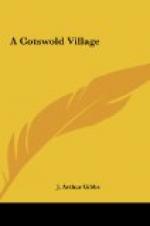The extensive Roman remains discovered some years ago in the heart of this forest doubtless formed the country house of some Roman squire. They are well away from the river bank, and about three parts of the way up the sloping hillside. The house faced as nearly as possible south-east. In this point, as in many others, the Romans showed their superiority of intellect over our ancestors of Elizabethan and other days. Nowadays we begin to realise that houses should be built on high ground, and that the aspect that gives most sun in winter is south-east. The old Romans realised this fifteen hundred years ago. In other words, our ancestors in the dark ages were infinitely behind the Romans in intellect, and we are just reaching their standard of common sense. The characteristics of the interior of these old dwellings are simplicity combined with refinement and good taste. And it is worthy of remark that the men who are ahead of the thought and feeling of the present day are crying out for more simplicity in our homes and furniture, as well as for more refinement and real architectural merit. No useless luxuries and nick-nacks, but plenty of public baths, and mosaic pavements laboriously put together by hard hand labour,—these are the points that Ruskin and the Romans liked in common.
With this grandly timbered valley spread beneath them, no more suitable spot on which to build a house could anywhere be found. And though the Romans who inhabited this villa could not from its windows see the sun go down in the purple west, emblematic of that which was shortly to set over Rome, they could see the glorious dawn of a new day—boding forth the dawn that was already brightening over England, even as “The old order changeth, yielding place to new";—and they could see the splendours of the moon rising in the eastern sky.
The principal apartment in this Roman country house measures about thirty feet by twenty; it was probably divided into two parts, forming the dining-room and drawing-room as well. The tessellated pavements are wonderfully preserved, though not quite so perfect as a few others that have been found in England. With all their beautiful colouring they are merely formed of different shades of local stone, together with a little terra-cotta. Perhaps these pavements, with their rich mellow tints of red sandstone, and their shades of white, yellow, brown, and grey, afforded by different varieties of limestone, are examples of the most perfect kind of work which the labours of mankind, combined with the softening influences of time, are able to produce. In one corner the design is that of a man with a rabbit in his hand; and no doubt there were lots of rabbits in these woods in those days, as well as deer and other wild animals long since extinct.




